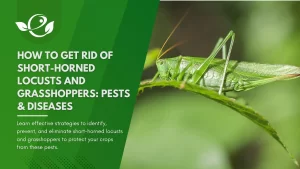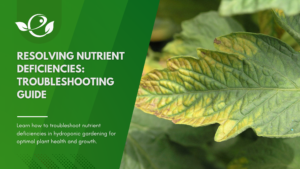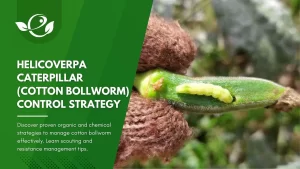Table of Contents
Alfalfa Mosaic Virus (AMV) is a silent adversary lurking in agricultural fields, capable of compromising the vitality of various crops and ornamental plants. This virus, often overshadowed by its more notorious viral counterparts, poses significant threats to crop health and yield, particularly in legumes like alfalfa. The battle against AMV requires not just an understanding of the symptoms but a strategic approach to prevention and management.
Alfalfa Mosaic Virus was first identified in alfalfa but has since been discovered in a wide range of hosts, spanning over 600 plant species. The virus’s ability to infiltrate and damage plant tissues is facilitated by a mosaic patterning of light and dark green patches on leaves, leading to a cascade of complications, including stunted growth and necrosis. Understanding the transmission methods, including insect vectors like aphids, and the role of environmental factors is critical in curbing its spread.
Preventing the Alfalfa Mosaic Virus is a multi-faceted endeavour, encompassing cultural practices, vector control, and the use of resistant varieties. Yet, even with the best preventive measures, managing AMV in infected plants remains a challenge due to the absence of direct antiviral treatments for plants. The focus shifts to integrated pest management strategies and supporting plant health to mitigate the impact of this virus.
In this comprehensive guide, we delve into the intricacies of AMV, exploring its symptoms, spread, prevention, and management, with the aim of equipping farmers, gardeners, and agricultural professionals with the knowledge to tackle this persistent threat effectively.
What is the Alfalfa Mosaic Virus?
Alfalfa Mosaic Virus (AMV) is a plant pathogenic virus belonging to the genus Alfamovirus within the family Bromoviridae. Discovered in alfalfa (Medicago sativa), the virus has a broad host range that extends beyond legumes, affecting solanaceous crops like tomatoes and potatoes, as well as ornamental plants. The virus is characterized by its RNA genome, which encodes proteins essential for virus replication, movement, and suppression of host defence mechanisms.
AMV is globally distributed, affecting crops in various climatic zones, from temperate to tropical regions. Its prevalence and the diversity of its host range make it a significant agricultural concern. The virus primarily spreads through aphid vectors in a non-persistent manner, meaning that the virus does not replicate within the insect but is quickly transmitted during feeding.

Symptoms of Alfalfa Mosaic Virus
Identifying the Alfalfa Mosaic Virus early is crucial for effective management. The virus manifests in several symptoms that can vary depending on the host species, environmental conditions, and the strain of the virus. Below are the key symptoms associated with AMV infection:
Early Symptoms
- Yellowing of Leaves (Chlorosis): One of the earliest signs of AMV infection is a generalized yellowing of the leaves, which often starts as interveinal chlorosis. This discolouration can resemble nutrient deficiencies, making early diagnosis challenging.
- Mosaic Patterns: The virus’s hallmark is the mosaic pattern on leaves, characterized by irregular patches of light and dark green areas. This pattern can vary in intensity and distribution across the leaf surface.

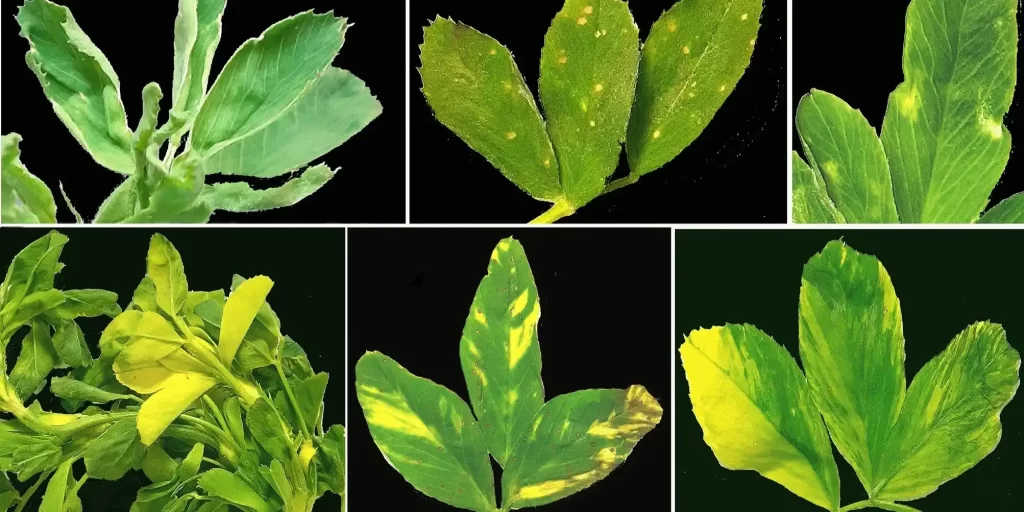
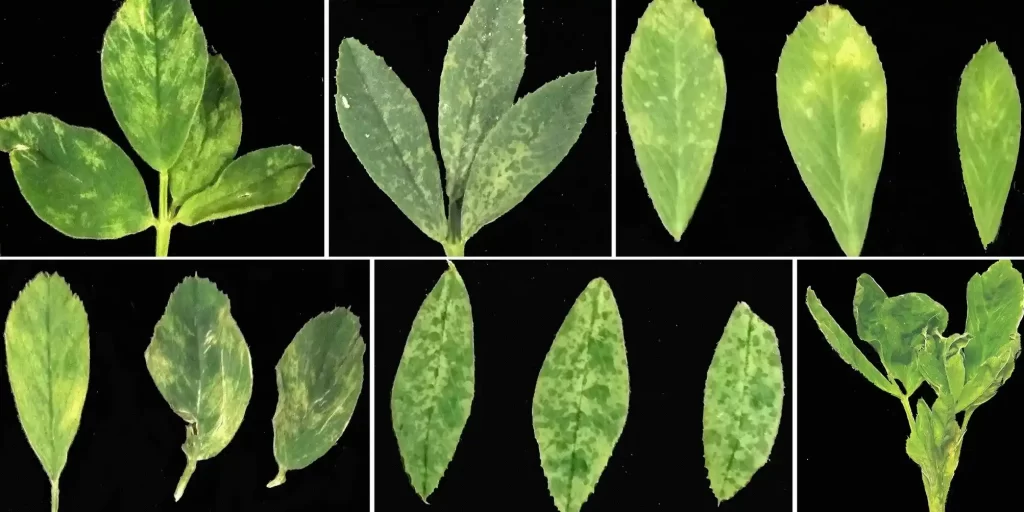
Advanced Symptoms
- Stunting of Plant Growth: As the infection progresses, plants exhibit stunted growth due to impaired photosynthesis and nutrient transport.
- Leaf and Stem Distortion: Infected plants may show distorted leaves with curling, crinkling, or malformation, and stems may become brittle or twisted.
- Necrotic Spots: Small, necrotic (dead) spots may develop on leaves and stems, leading to tissue death and further weakening of the plant structure.
- Reduced Yield and Quality: In crop plants like alfalfa, the virus can significantly reduce yield and forage quality, impacting livestock feed and agricultural profitability.
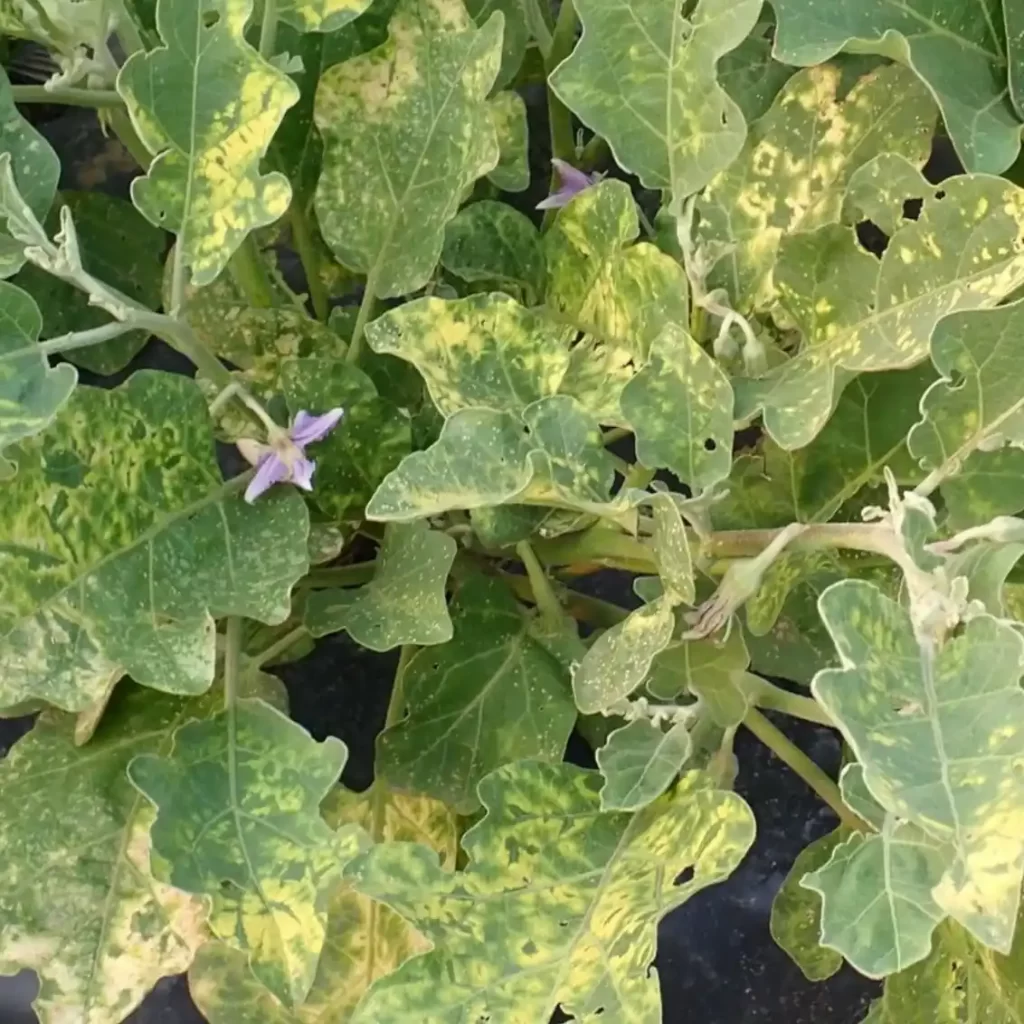


Identification Tips
Diagnosing AMV based on symptoms alone can be challenging due to similarities with other plant diseases or stress factors. Visual diagnosis should be complemented with laboratory testing, such as enzyme-linked immunosorbent assay (ELISA) or polymerase chain reaction (PCR), to confirm the presence of the virus.
Note: Alfalfa mosaic virus (AMV) infects over 400 plant species across the world. The virus is spread by numerous aphid species, and its symptoms include bright yellow mosaic patterns on leaves, leaf crinkling, and stunted growth of leaves, stems, and fruit.
How Alfalfa Mosaic Virus Spreads
Understanding the transmission pathways of AMV is essential for implementing effective control measures. The virus spreads through several mechanisms, with insect vectors playing a primary role.
Transmission Methods
- Insect Vectors: Aphids, such as the pea aphid (Acyrthosiphon pisum), are the main vectors of AMV. They transmit the virus in a non-persistent manner, acquiring the virus during brief feeding on infected plants and spreading it to healthy plants during subsequent feedings.
- Mechanical Transmission: The virus can also spread through contaminated tools, human activity, and the handling of infected plants. Mechanical transmission is common in greenhouses and nurseries where plants are frequently handled.
- Seed Transmission: The damage is caused by the seed-borne virus, which survives in infected seed or plant hosts. Some host plants can carry the virus in their seeds, leading to the emergence of infected seedlings. Seed transmission is particularly notable in crops like clover and beans.
Environmental Factors
Environmental conditions, such as temperature, humidity, and the presence of vector populations, can influence the spread of AMV. Mild temperatures and high aphid activity increase the likelihood of virus transmission. Additionally, stressed plants due to drought, poor nutrition, or other environmental factors may be more susceptible to infection.
Prevention of Alfalfa Mosaic Virus
Prevention is the most effective strategy against Alfalfa Mosaic Virus, as treatment options are limited once a plant is infected. Here are some key preventive measures:
Cultural Practices
- Use of Certified Virus-Free Seeds and Plants: Starting with clean planting material is fundamental. Use certified virus-free seeds and plants to reduce the initial inoculum.
- Avoid planting tomatoes near infected alfalfa fields.
- Crop Rotation: Implement crop rotation with non-host plants to break the virus’s life cycle and reduce the presence of the virus in the field.
- Removal of Infected Plants: Promptly remove and destroy infected plants to prevent the virus from spreading to healthy plants. This is especially important in greenhouse settings where the proximity of plants facilitates rapid spread.
Vector Control
- Managing Aphid Populations: Since aphids are the primary vectors, controlling their populations is crucial. This can be achieved through the use of insecticides, biological control agents (e.g., lady beetles), or organic options like neem oil.
- Reflective Mulches: Use reflective mulches in the field to deter aphid landing. These mulches create a visual barrier that confuses the insects, reducing their ability to locate and infest plants.
- Practice proper weed management.
Resistant Varieties
- Breeding and Use of Resistant Varieties: Breeding programs aim to develop varieties with resistance or tolerance to AMV. Using resistant varieties can significantly reduce the impact of the virus on crops.
Treatment for Alfalfa Mosaic Virus
Currently, there are no direct antiviral treatments available for plants infected with AMV. Therefore, management focuses on mitigating the impact of the virus and supporting plant health.
Organic Control
Use silver reflective mulches to delay the infection by aphid-borne viruses and reduce the incidence and severity of these diseases by repelling aphids that transmit them. Place reflective polyethylene mulches on planting beds before seeding or transplanting to reduce aphid landing and virus transmission.
Chemical Control
Always consider an integrated approach with preventive measures and available biological treatments. No effective chemical control strategies are currently available. Insecticides aimed at controlling the aphid vectors are ineffective.
Integrated Pest Management (IPM)
IPM combines cultural, biological, and chemical methods to manage pest populations and minimize the impact of diseases like AMV.
- Cultural Methods: These include crop rotation, sanitation, and the use of resistant varieties.
- Biological/Organic Control: Utilizing natural predators of aphids, such as lady beetles and parasitic wasps, can help keep vector populations in check.
- Chemical Control: When necessary, insecticides can be used to reduce aphid populations, but no effective chemical control strategies are currently available. However, the use of chemicals should be carefully managed to avoid resistance buildup and negative environmental impacts.
Supporting Plant Health
Maintaining optimal plant health through proper nutrition, irrigation, and stress management can help plants better cope with AMV infection. Healthy plants are generally more resilient and may exhibit less severe symptoms compared to stressed or weakened plants.
Best Practices for Managing Alfalfa Mosaic Virus
Effective management of AMV requires a combination of preventive measures and strategic interventions. Here are some best practices to consider:
- Regular Monitoring and Early Detection: Regular field inspections and monitoring for symptoms of AMV can facilitate early detection and prompt action. Scout for aphids and other potential vectors, as their presence can indicate a higher risk of virus spread.
- Training and Education: Educating farmers, gardeners, and agricultural workers on the symptoms, transmission, and management of AMV is essential for effective control. Knowledgeable personnel are better equipped to identify and respond to virus outbreaks.
- Sanitation Measures: To reduce the risk of mechanical transmission, ensure that tools, equipment, and hands are cleaned and sanitized when handling plants. This is especially important in nursery and greenhouse environments.
- Economic Impact of Alfalfa Mosaic Virus: The economic impact of AMV extends beyond individual crop losses. Reduced yields, lower-quality produce, and increased management costs can all contribute to financial strain on farmers and the broader agricultural industry.
- Effects on Crop Yield and Quality: AMV can cause significant reductions in crop yield, particularly in forage crops like alfalfa, where quantity and quality are critical. Infected plants produce less biomass, and the nutritional content of the forage may be compromised, affecting livestock feed value.
- Potential Financial Losses: The financial impact of AMV can be substantial, especially for small-scale farmers who rely heavily on affected crops. Costs associated with preventive measures, vector control, and replanting can add up, further straining resources.
- Broader Implications: Beyond the immediate effects on crop production, AMV can also affect trade and marketability. Infected plants may not meet quality standards for export, leading to potential trade restrictions and lost revenue opportunities.
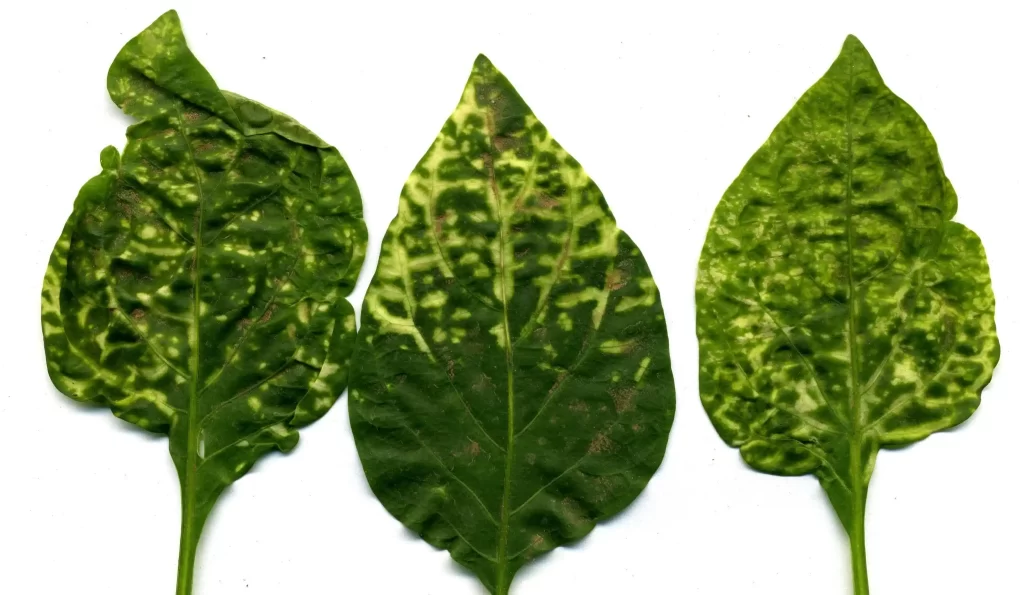
Final Thoughts
Understanding and managing the Alfalfa Mosaic Virus requires a proactive and informed approach. With its potential to affect a wide range of crops, including alfalfa and other legumes, the virus’s impact can be profound, influencing both agricultural productivity and economic viability.
By focusing on comprehensive prevention strategies, such as using virus-free seeds, controlling aphid populations, and employing resistant varieties, you can significantly mitigate the risk of AMV. Regular monitoring, timely intervention, and adherence to best practices will enhance your ability to manage this virus effectively.
As research advances and new management tools become available, staying updated on the latest developments will be crucial for maintaining healthy crops and ensuring agricultural sustainability. Whether you’re a farmer, gardener, or agricultural professional, the knowledge and strategies outlined in this guide will equip you with the tools necessary to combat the Alfalfa Mosaic Virus and protect your plants from this persistent threat.
FAQs
How can I confirm if my plants are infected with AMV?
Confirm AMV infection through laboratory testing methods such as ELISA or PCR. Visual symptoms alone may not be sufficient for accurate diagnosis.
Are there any resistant alfalfa varieties available?
Yes, some alfalfa varieties have been bred for resistance to AMV. Consult with seed suppliers or agricultural extension services for recommendations on resistant varieties.
What are the best practices for managing aphid populations?
Effective aphid management includes using insecticides judiciously, employing biological control agents, and implementing cultural practices such as reflective mulches and proper sanitation.
Can AMV be transmitted through irrigation water?
AMV is not typically transmitted through irrigation water. The primary modes of transmission are through aphid vectors and mechanical means.

